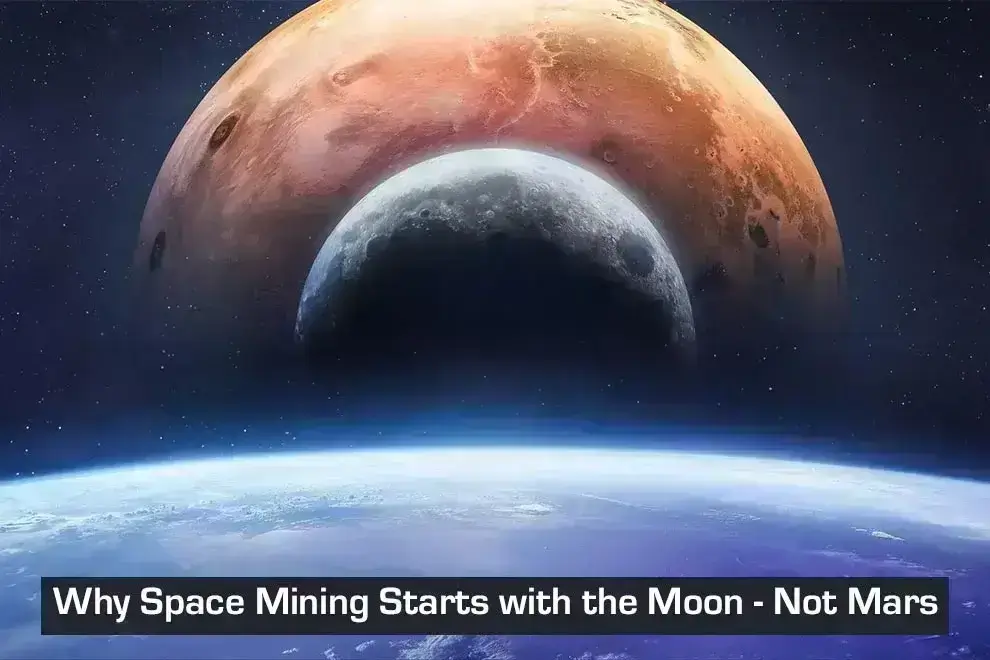When people dream about exploring space, they often picture Mars. It’s the red planet, after all – a symbol of the future. But when it comes to something practical like space mining, Mars isn’t our first stop. That honour goes to a much closer neighbour: the Moon.
More than just a glowing light in our night sky, the Moon is becoming a serious candidate for resource extraction. It’s close, relatively well-studied, and surprisingly useful when it comes to building the infrastructure for life and work beyond Earth. Let’s explore why mining the Moon makes more sense – for now – than heading straight to Mars.
It’s Way Closer
The Moon is only about 384,000 kilometres away from Earth. That’s roughly the distance a commercial jet would cover in 18 days – but in space travel terms, it’s just three days. Mars, in contrast, can be 55 million to 400 million kilometres away depending on orbital positions. A one-way trip to Mars takes at least six to nine months.
Shorter travel time means lower costs, faster mission turnaround, and safer logistics. If a mission to the Moon needs emergency supplies or adjustments, those can be delivered quickly. On Mars, a resupply mission could take months just to launch.
Also, spacecraft bound for the Moon need less fuel to get there and back. That translates to smaller launch vehicles, lower mission budgets, and more opportunities to run trial-and-error experiments without risking a decade of planning.
We Know the Terrain (Sort Of)
Our understanding of the Moon is far more advanced than Mars. Between the Apollo missions and modern probes, we’ve mapped significant portions of the lunar surface, analysed samples in Earth labs, and tested landing systems.
This matters for mining. We already know where certain materials – like ilmenite (a titanium-iron oxide mineral) – exist in abundance. We have detailed imagery of key regions, including permanently shadowed craters that may hold water ice. That kind of head start is invaluable when choosing a site for mining operations.
Mars, although explored by rovers and orbiters, still presents unknowns when it comes to surface composition, terrain hazards, and resource distribution. The Moon offers a lower-risk environment to test mining technologies.
It Has Useful Resources
The Moon isn’t just a dusty grey rock. It’s full of potential resources that could support human life and space operations. Here are some of the most important materials:
- Water Ice: Found in the permanently shadowed regions of the Moon’s poles, water is essential for drinking, growing food, and creating breathable oxygen. It can also be split into hydrogen and oxygen for rocket fuel, turning the Moon into a refuelling station for deeper space missions.
- Helium-3: This rare isotope, embedded in lunar soil by solar wind, could one day fuel nuclear fusion reactors. While fusion energy tech isn’t commercially viable yet, helium-3 offers a long-term incentive for lunar mining.
- Metals: The Moon contains aluminium, iron, titanium, and other construction materials. These could be used to 3D-print habitats, build solar panels, or repair machinery on-site, cutting down the need to ship heavy parts from Earth.
The ability to use local resources – called in-situ resource utilisation (ISRU) – is a game-changer for long-term sustainability in space.
Perfect for Testing Tech
We’ve never actually mined in space. We’ve landed on moons and planets, drilled for samples, and brought some rocks home – but no one has set up a full mining operation off Earth.
That’s where the Moon comes in. It provides a low-gravity (1/6th Earth gravity) environment that’s ideal for testing robotics, extraction tools, and processing techniques. It’s also close enough for semi-real-time remote operation. Commands from Earth take just 1.3 seconds to reach the Moon, compared to up to 20 minutes for Mars.
This delay is crucial. On the Moon, engineers can troubleshoot and even manually operate mining robots. On Mars, you’d need fully autonomous systems capable of making smart decisions without human input – which we’re not quite ready for yet.
The Moon also lets us try out closed-loop systems: testing how to recycle water, filter air, store energy, and reuse materials without constant resupply. It’s a safe, nearby platform to simulate longer-term missions further into space.
It Can Support Future Missions
Think of the Moon as a launchpad. If we can mine water and produce fuel on the Moon, we can dramatically reduce the amount of material we need to launch from Earth. That’s a big deal.
For example, launching a rocket from Earth is extremely energy-intensive due to our planet’s strong gravity. But launching from the Moon – where gravity is only one-sixth as strong – requires much less fuel. If we can produce fuel and construction materials on the Moon, it becomes a natural waypoint for missions to Mars, asteroids, or even beyond.
Imagine a future where spacecraft stop at a lunar base to refuel, recharge, or pick up extra cargo. The Moon could become a supply depot in space, making long-distance exploration far more efficient and realistic.
Mars Will Still Happen – Just Not Yet
There’s no doubt that Mars is on humanity’s to-do list. It has its own set of resources, like subsurface water ice, iron oxides, and possibly even carbon-rich materials. But it’s not the place to begin industrial-scale space operations.
Mars is just too far, too expensive, and too unpredictable right now. Establishing infrastructure there requires massive upfront investment and technologies we haven’t perfected yet.
By starting on the Moon, we can solve the hard problems close to home first – then use that experience to leap toward Mars with far greater confidence.
A Realistic Path Forward
We’re not just talking about a hypothetical future. This is already happening:
- NASA’s Artemis Program aims to land astronauts on the Moon again and set up a sustainable human presence.
- Commercial companies like Astrobotic, ispace, and Intuitive Machines are building landers and rovers designed for lunar cargo and exploration.
- Lunar Gateway, a small space station in orbit around the Moon, is being developed as a hub for future missions.
All of this is laying the groundwork for lunar mining and exploration. And with international cooperation increasing, we may see mining activities within the next couple of decades.
There are still legal challenges to work out, such as how to share resources and protect lunar heritage sites. But overall, momentum is building – and the Moon is the place where the space industry begins to take shape.
Why the Moon is Our Launchpad to Space Mining
The Moon may not have the red glow of Mars or the golden promise of asteroid metals, but it has something better: practicality. It’s close. It’s resource-rich. And it’s the perfect testing ground for everything we’ll eventually do farther from Earth.
If space mining is the future – and it likely is – then the smart move is to start where we have the best odds of success. The Moon isn’t just our satellite. It’s our first step into a much bigger universe.
Also Read: Space Tourism: The Race to Make Interplanetary Travel a Reality










